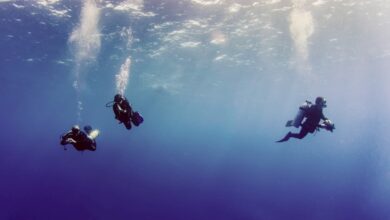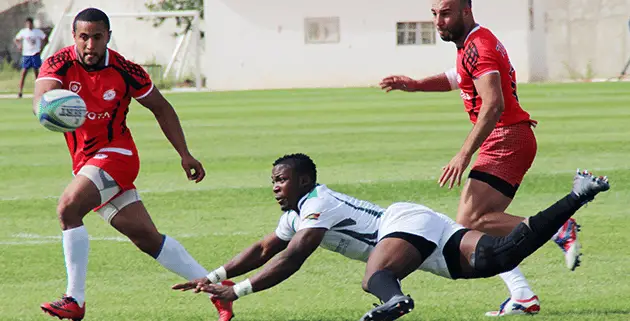Best Year Round Shark Diving Site in South Africa
Protea Banks, situated 7.5 km offshore from Shelly Beach on the KwaZulu-Natal South Coast, is the best year-round dive site for shark viewing. And the best dive operator to get you there is African Dive Adventures. Here’s why.
As a sixty-something-year-old Durban born Dive Master, I’ve been fortunate to have experienced the most popular (and many unheard of) Indian Ocean reefs along Africa’s coastline, stretching from the islands of Seychelles and Mauritius to Kenya, Tanzania, Mozambique, and South Africa; from Sodwana Bay to Durban and the sandstone reefs of Aliwal Shoal and Protea Banks, along the South Coast of KwaZulu-Natal.
Following hundreds of dives, in all weather conditions and seasons of my forty-plus years of recreational sport-scuba diving, I can confidently say that Protea Banks is the best dive site to see a wide range of shark species all year-round.
I have also dived with many of the operators and skippers along the coast, and believe me, some of them can easily be likened to South Africa’s notorious taxi drivers. African Dive Adventures, however, is an exception to the rule.
The information here is collected from our team who offer a range of cage diving and share diving adventures. Click here for the list of the best places to scuba dive in Africa.
African Dive Adventures
Owned and operated by Roland and Beulah Mauz, African Dive Adventures’ shop is located about 700m past the Shelly Centre Shopping Mall if you’re coming from the Durban/Port Shepstone direction. I met Beulah here on an overcast November afternoon in 2019 to get kitted out prior to my pre-booked dive arranged for the following morning (I’d left my own dive kit in Cape Town to avoid having to lug it along during my media FAM trip sponsored by Ugu South Coast Tourism – you can read that story at ‘Must-Visit Road Trip Attractions On The KZN South Coast‘).

Before I get into my actual dive experience with Roland and his team, let’s take a look at some of the shark species to be found at Protea Banks and the seasons during which these are most prevalent:
Shark Seasons at Protea Banks
Most shark species follow seasonal migratory patterns. What attracts them to this area is the high concentration of tuna (it’s one of the richest tuna grounds in the world). Below is a table showing months of the year in which certain species of shark are commonly encountered at Protea Banks (table courtesy of African Dive Adventures):

Here’s a brief summary of the shark species listed in the above table:
Blacktip Shark
Black Tips are medium-sized sharks (1.5 m / 4.9 ft) and are recognisable by their black-tipped pectoral, dorsal and tail fins that give this species their name. They are often mistaken for spinner sharks as both have torpedo-shaped bodies and are known for jumping (spinning) out of the water when feeding.

Females blacktips bear one to 10 pups every second year and the young blacktips spend their first months in shallow nurseries, which is why they are the most common species of shark found in the surf zone among bathers. As adults, the females return to the same nursery where they were born to give birth themselves.
Copper Shark
Although often seen at Protea Banks between June to October, copper sharks (aka bronze whaler, or narrowtooth shark) also follow the annual sardine run from May to July off the South African coastline. They grow to a length of 3.3 m / 11 ft and are difficult to distinguish from other large requiem sharks. They’re recognisable by their narrow, hook-shaped upper teeth (if you ever get close enough to notice), lack of a prominent ridge between the dorsal fins, and plain bronze upper body colouring.

Female copper sharks bear litters of 7 to 24 pups every other year in coastal nursery areas, after a gestation period of between 12 to 21 months. They’re extremely slow-growing, with males only reaching maturity between 13–19 and females between 19–20 years of age.
Guitarfish
Although Guitarfish have a typical shark-like form along the tail end, they are actually part of the ray family. In many guitarfish species (there are over 40 classified species), the head has a triangular, or guitar-like shape, rather than the disc-shaped head formed by fusion with the pectoral fins found in other rays.

Known locally as Sandshark or Flatfish, the Giant Guitarfish and Lesser Shandshark are bottom feeders, so you’ll spot them cruising the sandy patches between reefs.
Hammerhead Shark
Easily recognisable by their distinctive flattened and laterally extended “hammer” shaped heads, this shark species can range in size from 0.9 to 6.0 m (3.0 to 19.7 ft) in length and weigh anything from 3 to 580 kg (6.6 to 1,278.7 lb). Hammerheads form schools during the day, sometimes in groups over 100, while at night, like other sharks, they become solitary predators.

What’s really interesting about the hammerhead shark is the positioning of the eyes; being mounted on the sides of the shark’s hammerhead gives it 360° vision, meaning it can see above and below at all times. Another interesting fact is that hammerheads, like all sharks, have electroreceptors that lead from the head to sensory tubes, which detect electricity emitted by other creatures. In hammerheads, these receptors cover a wider area, like a larger radio antenna, so they can sweep for prey more effectively.
Sandtiger Shark
Protea Banks (and Aliwal Shoal) is also an ideal breeding ground for sharks. The spotted Sandtiger shark (aka ragged-tooth, grey nurse, or blue-nurse sand tiger), in particular, congregate here in their hundreds every year between May to November to mate.

After mating, the female ragged-tooth sharks (locally known as ‘Raggies’) remain behind, resulting in populations comprised almost exclusively of females. During their gestation period, the pregnant Raggies don’t eat and one can actually see algae growing on their rows of spike-like teeth. Raggies only give birth to one pup every second or third year, which makes this species one of the lowest reproductive rates for sharks. Although a female Raggie can have as many as 50 embryos, when one of them reaches 10 cm (4 in) in length, it eats all the others, leaving just one pup to be born fully independent at 1 m / 3.3 ft long (almost the size of an adult blacktip shark when born). Local legend has it that the female Raggies head further South towards the end of November to coincide their birthing with the spawning of Cape Hope squid along South Africa’s East Coast.

Gestating Raggies are incredibly inquisitive and if you remain still for long enough they will often come to investigate. I once experienced a female at Aliwal Shoal come out of her cave lair and press her snout on my mask for over a minute before losing interest and moving on,
Thresher Shark
Easily recognisable by its long tail, which is as long as the body of the shark itself and is used as a weapon to stun prey. The thresher shark has a short head and a cone-shaped nose. They are one of the fastest sharks in the ocean and can swim at a top speed of 48.2 kph (30 mph) and often jump out of the water when chasing prey, a behaviour known as breaching.

Thresher sharks are solitary creatures, although they do occasionally hunt in a group of two or three. There are three species of thresher shark; common, pelagic, and bigeye thresher.
Tiger Shark
Tiger sharks can grow to a length over 5 m (16 ft) and are named for the dark, vertical stripes found mainly on juveniles. As these sharks mature, the lines begin to fade and almost disappear. The fourth-largest shark on earth, the tiger shark is recognisable by its large head, blunt snout, slender body, and large eyes. Female tiger sharks tend to grow larger than males and can weigh in excess of 900 kg (2,000 lb).

Like most sharks, its teeth are continually replaced by rows of new teeth throughout the shark’s life. One of my favourite activities when diving Protea Banks and Aliwal Shoal is searching for teeth along the sandy ocean floor, and the Tiger tooth is instantly recognisable by its very sharp, pronounced serrations and an unmistakable sideways-pointing tip.
Whale Shark
As the largest fish in the sea, measuring over 13 m (45 ft) in length with a mouth-span of about 1.5 m (5 ft) and rows of over 300 teeth, whale sharks are docile filter feeders that sieve plankton through their gills and are completely harmless to humans.

Whale sharks have a lifespan that’s estimated to be 70 to 100 years and they reach sexual maturity at around 30 years of age. Diving with a whale shark is one of the most awe-inspiring experiences and I’ve been fortunate to have encountered them numerous times, especially at Sodwana Bay and Ponto do Auro in Mozambique, although they are often encountered at Protea Banks between the months of January to March.
White Shark
White shark (aka Great White or White Pointer) females can grow to 6.1 m (20 ft) in length and weigh between 1,905 to 2,268 kg (4,200–5,000 lb) at maturity, while males measure between 3.4 to 4.0 m (11 to 13 ft). While white sharks can live as long as 70 years or more, their breeding rate is slow. Male great white sharks take 26 years to reach sexual maturity, while the females take 33 years to be ready to produce offspring.

White sharks engage in a number of behavioural activities, ranging from courtship to complex social behaviour. Like Thresher sharks, they can move incredibly fast, with speeds estimated at over 56 km/h (35 mph) and they can dive to depths of 1,200 m (3,900 ft).
Zambezi Shark
Zambezi sharks (aka Bull shark) are known for their aggressive nature and are one of the few ocean shark species that can survive in both salt and freshwater, which is how their African name derived; by being found in the Zambezi River between Zambia and Zimbabwe, 2 574 km from the Indian Ocean.

Recognisable by their stocky shape, and broad, flat snout, adult female Zambezi sharks average 2.4 m (7.9 ft) long and typically weigh 130 kg (290 lb), whereas the slightly smaller adult male averages 2.25 m (7.4 ft) and 95 kg (209 lb). While a maximum size of 3.5 m (11 ft) is commonly reported, a single record exists of a female specimen of exactly 4.0 m (13.1 ft).
Here endeth the lesson! Now, back to my dive experience with African Dive Adventures.

After kitting up at the Shelly Beach ski-boat launch site (check out this 360-degree view), and completing the pre-dive safety and orientation briefing, Roland told me that they mostly cater to foreign tourists, which was why I was the only South African diver in the group. I asked what sets African Dive Adventures apart from its competitors in the area. “We believe in Ecotourism and Eco-Education and we fight for the conservation of Protea Banks, the inshore reefs and their inhabitants. We also cater for experienced divers, so, with us you will never be asked to look after a weaker buddy and you will never have to watch a beginner diver learning how to dive,” said Roland.

One of the fun parts of diving Protea Banks is the beach boat launch. As the dive group push and hold the boats’ nose into the oncoming surf, the skipper lowers the engines and, at his command, we all clamber on board (if you’re near the nose, as I was, that can be a problem without having fins to propel yourself out of the deepwater). As soon as everyone is kitted out with life vests, are seated, have their feet under the deck foot-straps, and holding onto the pontoon ropes, the skipper opens up, professionally guiding the boat through sets of oncoming waves (from my early days as a skipper and surfer, every 7th set of waves tend to be flatter than the preceding sets).

Most of the dive operators here use rigid inflatable boats (Ribs) due to their low-profile buoyancy and ability to punch through the surf. Roland and Beaula have a fleet of 4 Ribs, each licensed for 10 passengers plus two staff, with two of the boats equipped with a pair of powerful 100 HP four-stroke Suzuki outboard motors. These engines are so much better than the two-stroke outboards, which often make divers sitting at the rear nauseous from the oil-smoke emissions. “We will soon be replacing the other boat engines with four-stroke outboards – they are far more fuel-efficient,” said Roland as we rapidly crossed the 7,5 km distance from the shore to the drop-off zone. “If we can find them at the right price, that is,” he added.
Arriving at the drop-off zone, everyone passed their life jackets forward while weight belts were being passed back. After kitting up and buddy-checking that air cylinder valves were open, the group rolled backwards off the side pontoons and descended to about 35 metres on Protea Banks’ Southern Pinnacle at a spot named ‘Sand Shark Gully’, where true to its name, a gam of Giant Guitarfish could be seen hovering along the sand below.

As we slowly ascended, following the mild current and reef structure at an average depth profile of 19 metres, a shiver of Blackfin, along with the solitary Tiger shark and maternity of Raggies were spotted. Looking up at the surface during our 5 m deco stop, a toolbox of juvenile Scalloped Hammerhead bid us farewell.
Dive Time: 40 minutes
Bottom Time: 18 minutes
Average Depth: 19m
Maximum Depth: 35m.

In conclusion, I reiterate: Protea Banks is the best dive site to see the widest range of shark species all year-round, and the best dive operator to get you there is African Dive Adventures.
For more information visit www.afridive.com or to book a dive call or WhatsApp Beulah Mauz on +27 (0)82 456 7885. African Dive Adventures also have international booking offices in France, Germany, Holland, Switzerland, UK, and the USA.





